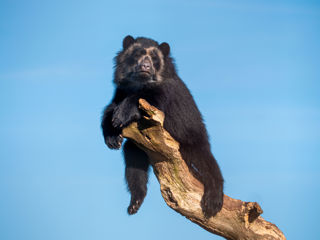
Bagot Goat
Scientific name: Capra aegagrus hircus
There are over 200 recognised species of goat. Most species of male goat naturally have two horns on the top of their head. The males use their horns to fight off rival males or predators.
Goats have excellent coordination. They are able to survive in extreme habitats such a steep mountainous areas. This is due to their outstanding balance. Goats can also climb trees and some species can jump over 5 feet!
Goats communicate by bleating. Mothers often bleat to their young (kids) to ensure their welfare. As soon as a kid is born it recognises its mother’s bleats and the mother instinctively knows the sound of her kid’s bleats too.
Goats are closely related to sheep which is why they look so similar. Like sheep, goats are bred for milk, meat and wool.
We have Boer and Angora goats here at the zoo. The Boer goat is a breed of goat that was developed in South Africa for meat production. Their name is derived from the Afrikaans (Dutch) word boer, meaning farmer. Angora is a breed of domesticated goat that is named after Ankara, Turkey, historically known as Angora. Angora goats are farmed commercially for their mohair fleece.

-
We live...
On the hill, left of the entrance, next to the Red Deer
-
Fun Fact
The Myotonic goat (also known as the ‘Tennessee Stiff- Leg’) is a species of goat which is famous for fainting!
-
Food Fact
Goats are herbivores. They mostly eat grass and shrubs.

Adopt Me
You can support our conservation efforts and help with the costs of keeping rare and wonderful zoo animals by adopting a Goat. Adopt a Goat for yourself or as a gift.
You might also like...
-
![Meerkats]()
Meerkat Keeper Talk
Come along and learn about our mob of Meerkats from our experienced animal keepers.
Find out more
-
![Zoe And Falcon]()
Bird of Prey Flying Display
Watch our majestic birds of prey in our new Wings of Wonder flying display.
Find out more
-
![Andean Bear]()
Bear Keeper Talk
Learn about our Spectacled bears from our experts and find out what it is like to be a Spectacled bear keeper.
Find out more
-
![African Elephant - Shaka 2]()
Elephant Keeper Talk
Did you know Elephants are the largest land animals on Earth? Come and join our Elephant Keepers and learn about our bulls.
Find out more






